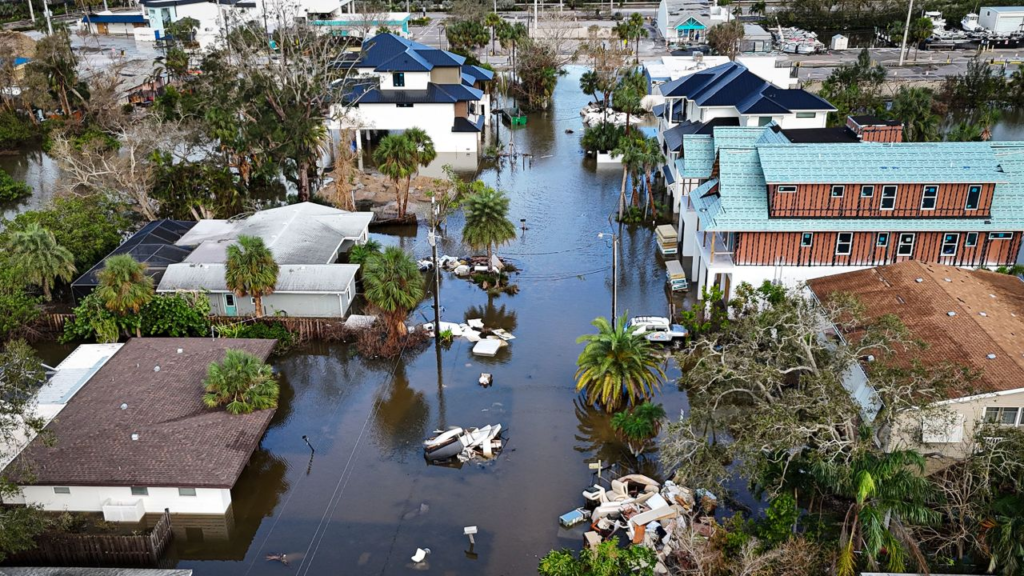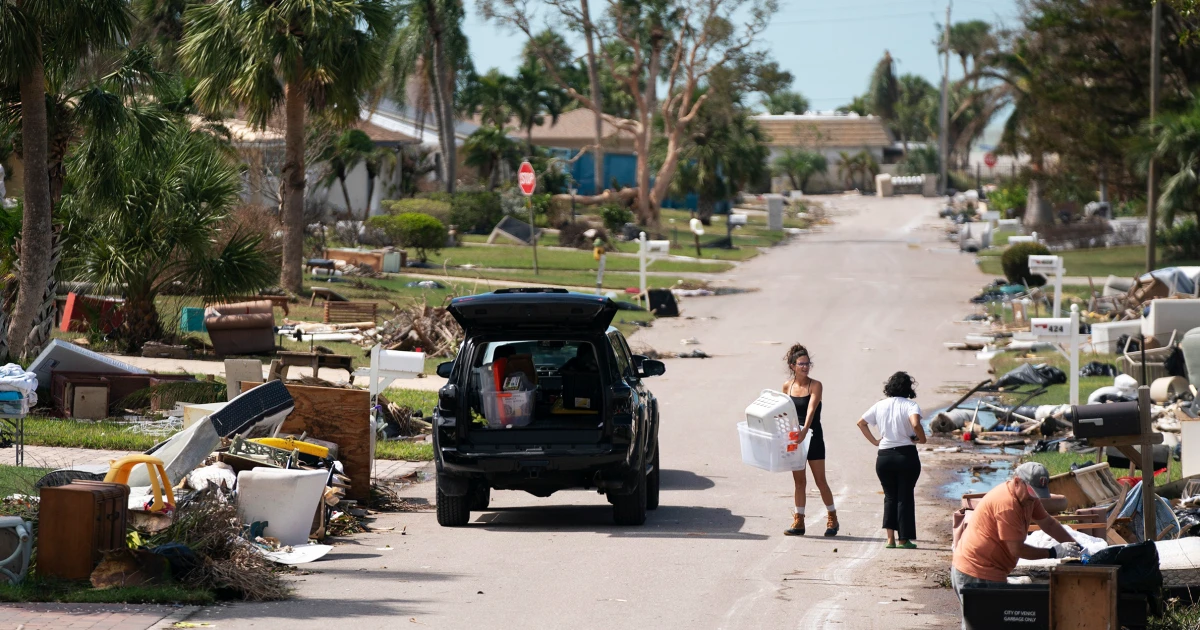Hurricane Milton made landfall on the coast of Florida as a powerful Category 3 storm, leaving a path of devastation and claiming at least 16 lives. The storm wreaked havoc on communities that were still recovering from Hurricane Helene, which had struck just two weeks earlier.
With widespread flooding, powerful tornadoes, and massive power outages, Florida found itself grappling with the aftermath of yet another deadly hurricane. This blog takes a deep dive into the impact of Hurricane Milton, the ongoing recovery efforts, and the role of climate change in intensifying the storm.
The Path of Destruction Left by Hurricane Milton
Hurricane Milton struck Siesta Key, a picturesque barrier island near Sarasota, late on Wednesday night, unleashing heavy winds and torrential rains. As the storm moved across Florida, it uprooted trees, damaged buildings, and left entire communities submerged in water.
Read : Florida Highway Full of Cars as People Evacuate Ahead of Hurricane Milton
The island of Siesta Key, which was directly in the storm’s path, experienced significant damage. Flooded streets, fallen trees, and debris scattered across roads and properties created a desolate landscape. Homes were battered, with furniture and appliances strewn about—much of it left behind by residents who had evacuated ahead of the storm.
Read : ISS Shares Video of Hurricane Beryl from 400 km Above Space: Watch
Mark Horner, a resident of Siesta Key for six years, recounted the shock of seeing his once-idyllic community transformed into a disaster zone. While his home was largely spared, many others were not so fortunate. Streets remained flooded, and residents found themselves reassessing the future of their homes and businesses.
Despite the devastation, Horner remained optimistic, expressing hope that “our paradise will come back.” However, for many, the storm’s impact raised deeper concerns about the long-term viability of living in such vulnerable areas.
The storm wasn’t just limited to Siesta Key; its powerful winds and rains were felt across the Florida peninsula. Cities such as Tampa, Fort Pierce, and Orlando also bore the brunt of the storm. The dome of Tropicana Field in St. Petersburg was torn open by the hurricane’s winds, highlighting the storm’s destructive force.

Despite the damage, Governor Ron DeSantis acknowledged that the storm, while severe, was not as catastrophic as many had feared, offering a small glimmer of relief to a state already reeling from the back-to-back storms.
Tornadoes and Floods: The Deadly Aftermath of Hurricane Milton
While the hurricane’s winds caused extensive damage, many of the fatalities were attributed to the tornadoes that Milton spawned. Tornado warnings were issued across the state as the storm moved inland, with at least 126 tornado warnings recorded on Wednesday alone.
In Fort Pierce, on Florida’s Atlantic coast, four people tragically lost their lives in a tornado. Some of the victims were found outside, caught in the storm’s fury. The tornadoes, coupled with widespread flooding, created a deadly combination that left communities devastated.
In addition to the fatalities in Fort Pierce, several other counties reported lives lost due to the storm. Six people died in St. Lucie County, four in Volusia County, and others in Pinellas, Hillsborough, Polk, Orange, and Citrus counties. Despite the loss of life, the state was spared the widespread devastation that had been feared in the lead-up to the storm.
Emergency responders worked tirelessly to rescue those trapped by the storm, including a dramatic Coast Guard operation that saved a boat captain who had ridden out the storm clinging to a cooler in the Gulf of Mexico.
Residents across the state were left grappling with the storm’s aftermath. In Tampa Bay, some homes were completely flooded, leaving families displaced. Lidier Rodriguez, whose apartment was inundated with water, expressed the emotional toll of losing everything to the storm.

“It is not easy to think you have everything and suddenly you have nothing,” he said, capturing the sentiment of many Floridians who found themselves rebuilding their lives once again.
The Role of Climate Change in Amplifying Hurricane Milton
As Floridians cleaned up in the wake of Hurricane Milton, experts began analyzing the factors that had intensified the storm. The World Weather Attribution group, a team of climate scientists, released a report indicating that human-induced climate change had played a significant role in making the storm more destructive.
According to the report, heavy one-day rainfall events like those associated with Hurricane Milton have become 20-30 percent more intense due to climate change. Furthermore, such events are now twice as likely to occur in today’s climate compared to pre-industrial times.
Milton’s wind strength was also amplified by climate change. What could have been a less intense Category 2 storm was instead pushed into the Category 3 range due to the warming atmosphere.
The report suggested that Milton’s winds were about 10 percent stronger than they would have been in the absence of climate change, further underscoring the dangers of a warming planet.
For many Floridians, the relentless barrage of hurricanes has brought the reality of climate change to their doorstep. Back-to-back storms like Helene and Milton have left communities battered and vulnerable, with residents increasingly questioning whether they can continue to live in such high-risk areas.
Joe Meyer, a 58-year-old resident of Madeira Beach, reflected on the challenges of rebuilding after two major storms in such a short span of time.
After spending five days in a hotel following Helene’s destruction, Meyer returned home only to face more wind damage from Milton. “We’ll probably sell,” he admitted, adding that the constant threat of hurricanes had become too much to bear.

The frequency and intensity of hurricanes like Milton are expected to increase in the coming years as climate change accelerates. Experts warn that without significant efforts to reduce carbon emissions and curb global warming, more storms like Milton will continue to ravage vulnerable coastal communities. For now, Florida is left to pick up the pieces once again, as residents begin the long process of recovery and rebuilding.
Hurricane Milton left a trail of destruction across Florida, claiming the lives of at least 16 people and leaving millions without power. The storm’s impact was felt from the Gulf Coast to the Atlantic Ocean, with communities still reeling from the devastation wrought by Hurricane Helene just weeks earlier.
Despite the immense damage, Floridians remain resilient, with many expressing hope for the future as they begin the process of rebuilding their homes and lives.
Yet, the storm also served as a stark reminder of the growing threat posed by climate change. As hurricanes become wetter, windier, and more destructive, the state will need to grapple with the reality that these storms are likely to become more frequent and intense in the years to come.
For now, Florida can only look to the future with hope, while recognizing the urgent need to address the underlying factors driving these increasingly dangerous storms.
let’s enjoy few years on earth with peace and happiness….✍🏼🙏

